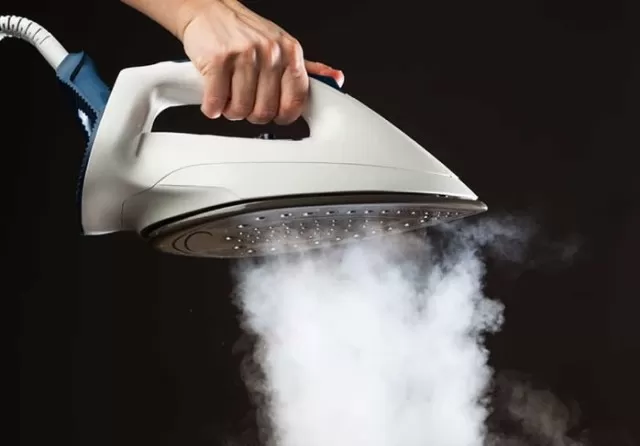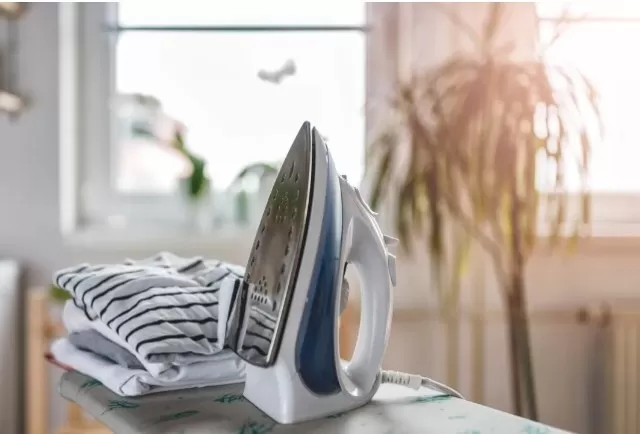Iron Cleaning Guide: Inside and Out, a Sparkling Appliance. Your iron is a trusty ally in banishing wrinkles from your clothes. However, to ensure its optimal performance and prevent damage to your garments, it’s crucial to keep this appliance clean. Over time, residue, mineral deposits, and mildew can accumulate on the soleplate and inside the water tank, impacting both efficiency and safety.
To spare yourself additional ironing woes, master the art of iron cleaning. Follow these expert-approved steps to maintain your iron in prime condition, ensuring its longevity and providing you with years of crisp, well-pressed clothes
Iron Cleaning Frequency: A Guide to Lasting Brilliance

The cleaning frequency for your iron largely depends on its usage, according to Kathy Cohoon, Director of Franchise Operations at Two Maids.
By considering your ironing habits, you can establish an effective cleaning cadence to maintain its performance and safeguard your garments.
If you use your iron daily, Cohoon recommends cleaning it at least once a month to ensure optimal functionality.
Regular cleaning not only keeps the iron visually pleasing but also protects the soleplate from wear and tear, preventing fabric burns and prolonging the iron’s lifespan.
For those who use their iron sporadically, aim for a thorough deep clean a couple of times a year.
This occasional maintenance routine helps keep the iron in excellent condition and ready for use when needed.
By adhering to a suitable cleaning schedule based on your ironing frequency, you can preserve its brilliance, prevent potential fabric damage, and avoid the need for premature replacement.
Embrace regular maintenance to keep your iron performing at its best and ensuring many wrinkle-free moments ahead.
Iron Cleaning Simplified: Steps for a Pristine Appliance
Your iron, a trusty cleaning tool, requires its own care to maintain optimal performance.
Routine maintenance is essential to ensure its functionality and prevent issues down the line. Kathy Cohoon emphasizes the importance of proper care, including emptying the water reservoir after each use to avoid mold and buildup.
Follow these straightforward steps to clean your iron effectively:.
Empty the water reservoir: After every use, empty the water reservoir to prevent stagnant water from causing mold and buildup.
Allow the iron to cool down before disposing of the water.
Exterior wiping: Regularly wipe the exterior surfaces of the iron with a damp cloth to remove any dust, stains, or residue.
Ensure the iron is unplugged and cooled before cleaning.
Soleplate care: If the soleplate has residue or mineral deposits, create a paste with baking soda and water.
Gently scrub the soleplate using a soft cloth or sponge. Wipe away any residue with a clean, damp cloth.
Deep cleaning if necessary: If the iron exhibits significant buildup or mineral deposits, consider descaling it.
Follow the manufacturer’s instructions for descaling solutions or use a mixture of equal parts vinegar and water. Fill the reservoir, heat the iron, and allow the solution to steam through.
Rinse the reservoir thoroughly afterward.
By incorporating these simple cleaning practices into your iron maintenance routine, you can keep your appliance in excellent condition, prevent mold or buildup, and ensure it continues to serve you well in your cleaning endeavors.
Unleashing Efficiency: Embracing the Iron\’s Self-Clean Function

Experts at Black + Decker highlight the presence of a self-cleaning feature in many irons, which offers a convenient and effective cleaning solution.
To maximize your iron’s potential and ensure optimal performance, it is recommended to utilize this self-clean option by following the manufacturer’s instructions.
Here’s how to make the most of your iron’s self-cleaning function:.
Read the manufacturer’s instructions: Familiarize yourself with the specific self-cleaning instructions provided by the iron’s manufacturer.
These instructions may vary depending on the model, so it is crucial to follow them accurately.
Prepare for self-cleaning: Ensure the iron is unplugged and cooled down before initiating the self-cleaning process.
Place the iron on a suitable surface, such as a heat-resistant mat or a towel, to protect the surrounding area.
Activate the self-cleaning function: Follow the manufacturer’s guidelines to activate the self-clean feature.
This typically involves filling the water reservoir with the recommended cleaning solution or water-vinegar mixture. Once initiated, the iron will generate steam to clean the internal components.
Rinse thoroughly: After the self-cleaning process is complete, rinse the iron by filling the reservoir with Clean Water.
Activate the steam function and allow the water to steam through the iron to flush out any remaining cleaning solution or residue.
Wipe and dry: Once rinsed, use a clean, dry cloth to wipe the soleplate and exterior surfaces of the iron.
Ensure the iron is completely dry before storing or using it again.
By harnessing the power of the self-cleaning function, you can effectively remove residue, mineral deposits, and impurities from your iron’s internal components.
This helps maintain its performance, prolong its lifespan, and ensure optimal results in your ironing endeavors. Embrace the manufacturer’s instructions and unlock the efficiency of your iron’s self-cleaning capabilities.
Refreshing Brilliance: Removing Stains from Your Iron\’s Soleplate

The sticky black stains that accumulate on your iron’s soleplate, a combination of burn marks, melted fabric fibers, water deposit buildup, dirt, and dust, can be effectively tackled with two simple cleaning essentials: a dry cotton towel and salt, as recommended by Peterson.
Follow these steps to refresh your iron’s soleplate and restore its pristine condition:.
Preparation: Ensure your iron is unplugged and completely cooled before starting the cleaning process.
This prevents any risk of injury.
Sprinkle salt on the towel: Take a dry cotton towel and sprinkle a generous amount of salt onto it.
The salt acts as an abrasive agent to aid in the removal of stains.
Rub the soleplate: Gently rub the salted towel over the stained areas of the soleplate.
Apply light pressure and use circular motions to effectively remove the stains. The salt will help lift the residue and restore the soleplate’s cleanliness.
Wipe off residue: After treating the stains, use a clean, dry cloth to wipe away any remaining salt residue from the soleplate.
Check and repeat if necessary: Inspect the soleplate to ensure all stains have been removed.
If any stubborn stains persist, repeat the process until the soleplate is entirely clean.
Final wipe-down: Once the stains are removed, use a damp cloth to wipe the soleplate and remove any remaining salt particles.
By utilizing the power of salt and a dry cotton towel, you can effectively remove sticky black stains from your iron’s soleplate.
This simple cleaning technique helps restore the performance and efficiency of your iron, ensuring smooth and wrinkle-free results for your garments.
Sustaining Brilliance: Maintenance Practices for an Impeccable Iron

Maintaining the cleanliness and performance of your iron is achievable with a few simple practices, as advised by our experts.
By following fabric care instructions, using appropriate heat settings, and incorporating regular maintenance, you can extend the lifespan of your iron and ensure smooth operation. Kathy Cohoon emphasizes the importance of these practices.
Implement the following tips to keep your iron in optimal condition:.
Fabric care adherence: Follow fabric care instructions when ironing different materials to avoid damage or staining.
Each fabric has specific heat requirements, so adjust the iron’s temperature accordingly.
Moderate heat settings: Avoid using excessively high heat settings, as they can cause damage to the iron and garments.
Select the appropriate temperature for the fabric being ironed, ensuring efficient and safe operation.
Wipe down after each use: Once the iron has cooled down, wipe the soleplate and exterior surfaces with a microfiber cloth to remove any residue or dust.
Regularly wiping the exterior helps maintain a clean and polished appearance.
Empty water reservoir: After each ironing session, empty the water reservoir to prevent trapped moisture that can lead to mold buildup.
Replace the water with fresh water for the next use.
Periodic deep cleaning: Consider performing a deep clean of the iron, including the soleplate and internal components, as recommended by the manufacturer.
This helps remove stubborn residue and maintains optimum performance.
By incorporating these maintenance practices into your iron care routine, you can keep your appliance in impeccable condition, promoting longevity, efficiency, and providing you with reliable and satisfactory results.
Embrace these proactive measures to ensure an extended lifespan for your iron and the preservation of its performance.
*The information is for reference only.